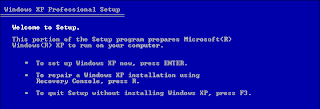Getting to the Windows Recovery Console
- Insert your Windows XP CD into your CD and assure that your CD-ROM drive is capable of booting the CD. Configuring your computer to boot from CD is outside of the scope of this document, but if you are having trouble,
- Once you have booted from CD, do not select the option that states: "Press F2 to initiate the Automated System Recovery (ASR) tool." You're going to proceed until you see the following screen, at which point you will press the "R" key to enter the recovery console:

- After you have selected the appropriate option from step two, you will be prompted to select a valid Windows installation (Typically number "1"). Select the installation number, (As mentioned, "1" in most cases), and hit enter. If there is an administrator password for the administrator account, enter it and hit enter. You will be greeted with this screen, which indicates a recovery console at the ready:

Proceeding With the Repair Functions
- There are eight commands you must enter in sequence to repair any of the issues I noted in the opening of this guide. I will introduce them here, and then show the results graphically in the next six steps. These commands are as follows:
- C:\windows> ATTRIB -H C:\boot.ini
- C:\windows>ATTRIB -S C:\boot.ini
- C:\windows>ATRIB -R C:\boot.ini
- C:\windows> del boot.ini
- C:\windows> BOOTCFG /Rebuild
- C:\windows> CHKDSK /R /F
- C:\windows> FIXBOOT
the BOOTCFG /REBUILD command which searches for pre-existing installations of Windows XP and rebuilds sundry essential components of the Windows operating system, recompiles the BOOT.INI file and corrects a litany of common Windows errors. It is very important that you do one or both of the following two things: First, every Windows XP owner must use /FASTDETECT as an OS Load Option when the rebuild process is finalizing. Secondly, if you are the owner of a CPU featuring Intel's XD or AMD's NX buffer overflow protection, you must also use /NOEXECUTE=OPTIN as an OS Load Option. I will demonstrate both commands for the purpose of this guide, but do not set NOEXECUTE as a load option if you do not own one of these CPUs. For the "Enter Load Identifier" portion of this command, you should enter the name of the operating system you have installed. If, for example, you are using Windows XP Home, you could type "Microsoft Windows XP Home Edition" for the identifier. This gives the process some authenticity, if you're keen on being a perfectionist.
the ckdsk command checks integrity of the hard drive containing the Windows XP installation. While this step is not an essential function in our process, it's still good to be sure that the drive is physically capable of running windows, in that it contains no bad sectors or other corruptions that might be the culprit. No screenshot necessary here! Just type CHKDSK /R /F at the C:> prompt. Let it proceed; it could take in excess of 30 minutes on slower computers..
FIXBOOT. This writes a new boot sector to the hard drive and cleans up all the loose ends we created by rebuilding the BOOT.INI file and the system files. When the Windows Recovery Console asks you if you are "Sure you want to write a new bootsector to the partition C: ?" just hit "Y," then enter to confirm your decision.Results and Wrap-Up
It's time to reboot your PC by typing EXIT in the Windows Recovery Console and confirming the command with a stroke of the enter key. With any luck, your PC will boot successfully into Windows XP as if your various DLL, Hive, EXE and NTLDR errors never existed. You've just saved yourself from many hours of work, frustration, potential data loss and shelling out your hard earned money

0 comments:
Post a Comment